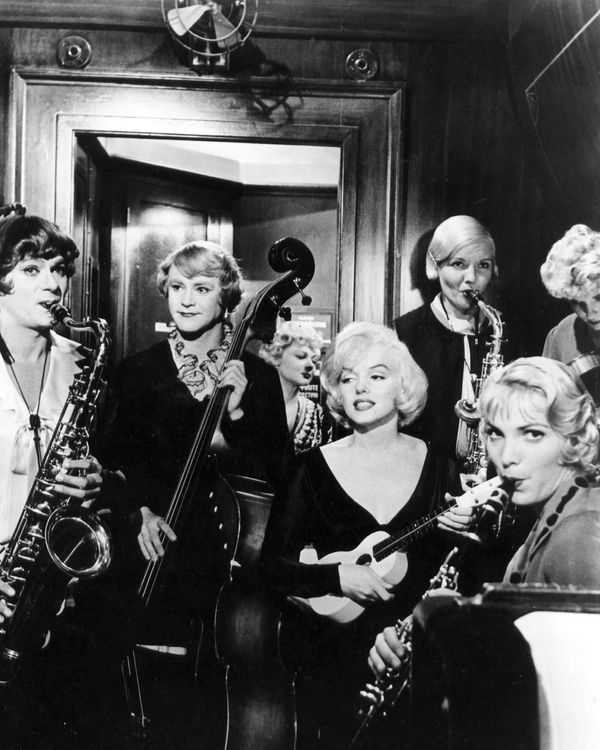
Every week for the foreseeable future, Vulture will be selecting one film to watch as part of our new Friday Night Movie Club. This week’s selection comes from our film critic Angelica Jade Bastién, who will begin her screening of Some Like It Hot on March 20 at 7 p.m. ET. Head to Vulture’s Twitter to catch her live commentary, and look ahead at next’s week movie here.
As life continues to be mired in destabilizing uncertainty, I’ve been seeking pleasure in the things that ground me in my body — cooking and savoring a lush meal, dancing around my apartment to Megan Thee Stallion and Duran Duran, and watching films that remind me of the happiness of living and being present in a human body. The current leading example: Some Like It Hot, the 1959 film directed, produced, and co-written by Billy Wilder.
It’s 1929, Chicago. A city of slick asphalt, well-dressed gangsters, people on the make, and funeral parlors that double as speakeasies. On the bandstand of one such speakeasy you’ll find musicians Joe (Tony Curtis) and Jerry (Jack Lemmon). The first is smooth and dangerous, a cad of sorts who flaunts bedroom eyes and beckoning one-liners. The latter has a nervous, almost manic energy born out of the anxiety that comes with being the more levelheaded of the two. Their routine lives get splintered, however, when they witness the St. Valentine’s Day Massacre committed by gangster and bootlegger Spats Colombo (George Raft). The setup suggests the makings of a claustrophobic noir about two friends on the run. But Wilder and co-writer I.A.L. Diamond wring this story for humor and hijinks, as Joe and Jerry opt not just to run, but to also disguise themselves as women — Josephine and Daphne, respectively. They join an all-women’s band and hightail it to Florida. The film really starts there, with the introduction of Sugar Kane (Marilyn Monroe), a singer and ukulele player who, to quote Jerry, walks like “jello on springs.”
Some Like It Hot is a film in service of the pleasure principle. Its supporting cast bursts with memorable turns. The humor is bright and sharp and endlessly beguiling. The costuming by Orry-Kelly marks Some Like It Hot as a world onto itself — not quite 1929, but definitely not 1959; a time period that can only exist in the magic of film. In recent days, I’ve turned to the film for the premium it places on community — the characters drink together, dance ecstatically together, frolic on the beach without any care about what comes next.
Tony Curtis and Jack Lemmon are perfect in their roles, imbuing a unique physical humor into every step and glance. They’re in constant conversation with each other without saying a word, gestures that signal a deeper kind of friendship. And as women, they’re forced to exist in a space with new kinds of freedom and restrictions alike, particularly as Jerry/Daphne finds himself hounded by an aging billionaire, divorced seven times over (played marvelously by Joe E. Brown). Their approaches to femininity differ. Joe has always been aware of his masculine presence and veers in the opposite direction as a result, but for Jerry, things are a bit more dynamic, even queer. Here, becoming a woman reveals as much as it hides.
But to be completely honest, I return to this film for the wounded performance of Marilyn Monroe. You probably formed an idea of Monroe long before you ever saw her onscreen. Perhaps you caught sight of her flattened image — red lipped and yearning — plastered on a mug, Andy Warhol–style. Maybe you learned through osmosis to regard her as a tragedy. Monroe is a cinematic atom bomb mushrooming with significance. In death she’s become for many artists and writers an emblem of 1950s sexuality, a feminist icon, a victim, a muse. Personally, I’d rather focus on what she did onscreen, where she’s decadently hilarious, brimming with fully realized emotion. At first blush, Sugar could be discarded as just another example of the dumb-blonde archetype. Hell, she calls herself dumb. But I think she’s too self-aware for that. Monroe balances the needs of the character beautifully. Watch as her face melts like ice cream when she notes how she always “gets the fuzzy end of the lollipop.” Watch how she leans over Joe late in the film, her body a canvas upon which the film displays its notions of sex and desire. This is a movie about desire above all else, and the hilarious ways we strive for it.
In the Criterion Collection’s representation of the film, Sam Wasson contends, “Some Like It Hot isn’t Tootsie; it’s not interested in how the experience of being a woman can make men better men. This is a Billy Wilder movie; it’s about the Machiavellian lengths to which people will go to get what they want, which is never much nobler than money, sex, or self-preservation. Wilder was America’s id.” And there’s truth to that. But Wasson does the film a disservice by restricting its message to “good sex.” I contend that Some Like It Hot is brimming with meaning. It celebrates the dynamism of the human experience, and these wondrous bodies of ours, in a far more expansive way than we’ve given it credit. And it’s for this very reason that we’re choosing it as our first Friday Movie Night Club pick.
Some Like It Hot is available to stream with a subscription to The Criterion Channel or Amazon Prime, and is also available to rent on iTunes, Google Play, YouTube, and Vudu.


